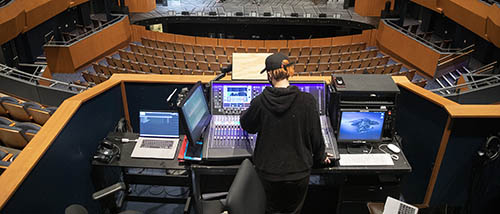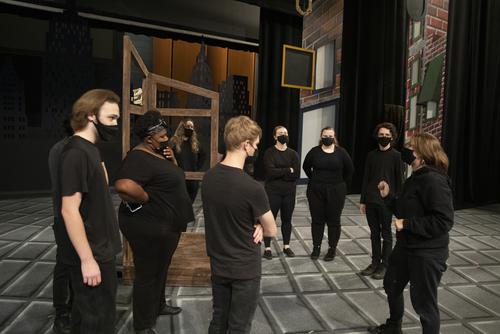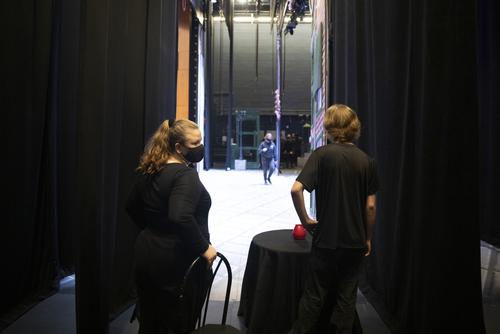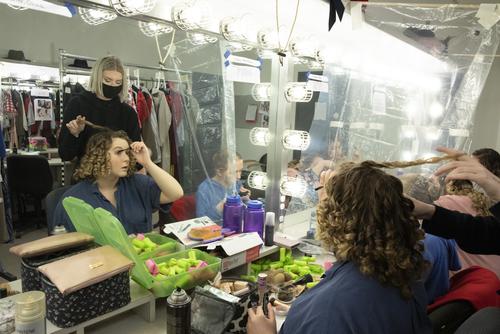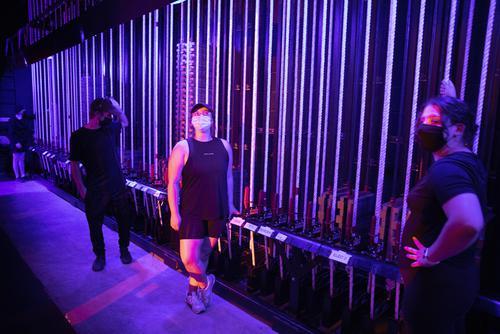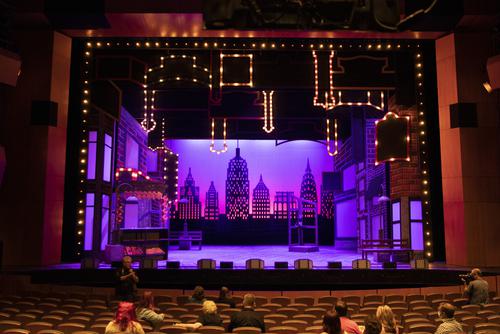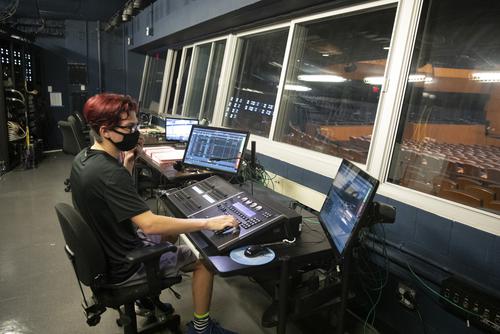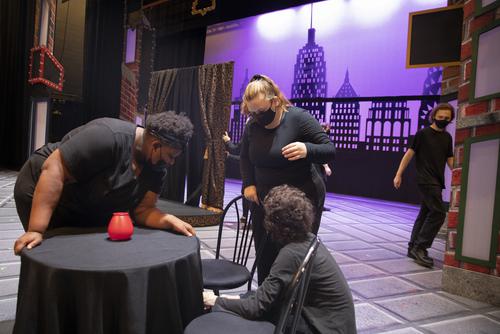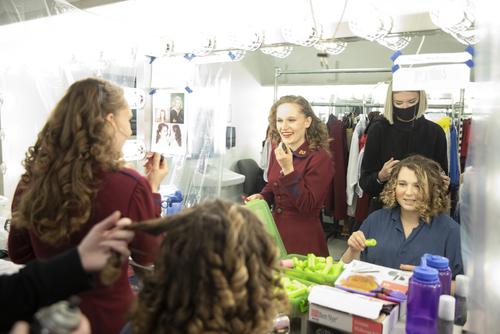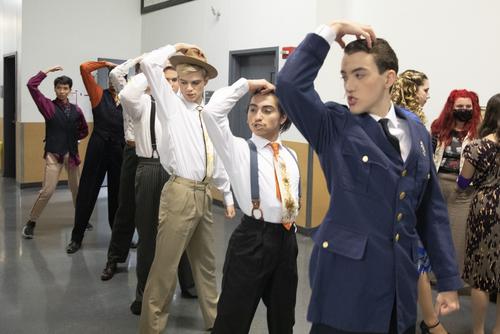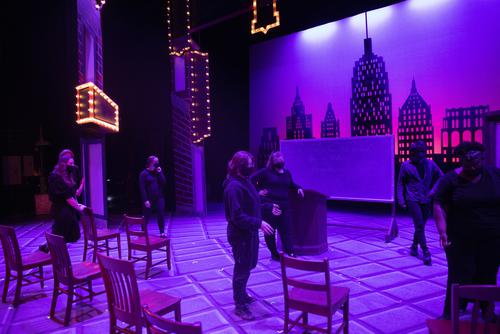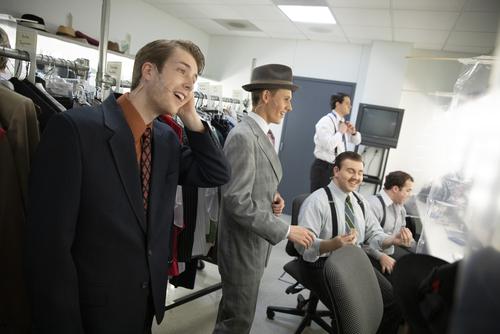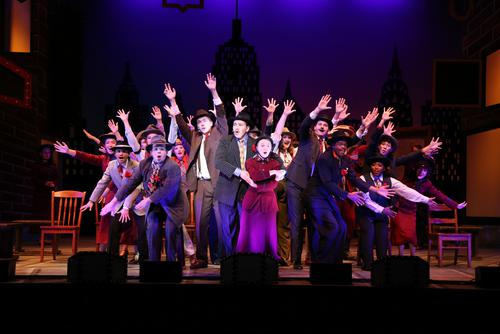Putting together a full-scale musical theatre production is no easy feat. It goes far beyond the actors on stage.
Thanks to Southeast’s Design and Technology program, we’ve got a lot of extremely talented students ready to take on the challenge. We spent some time chatting with three members of the crew to see what it takes to put on such an incredible production.
Managing the Stage
Mary K. Cook is a Senior from Antioch, Illinois. She came to Southeast specifically for the program because she wants to be a stage manager. That was her job on “Guys and Dolls.” The stage manager is involved in production from almost day one. Mary was a part of the very first production meeting in which the production team gets together and listens as the director pitches his concept for the show and gets everything underway. Once the cast is in place, it’s Mary’s job to record all the stage blocking, notes about lines, and pretty much keep track of everything happening with the production.
When the process moves from rehearsals to Tech Week, the week before the opening night of the show when all of the technical elements are put in place, the stage manager takes over. It’s their job to quite literally run the show.
At Southeast, students are assigned a major role like stage manager for one show a semester. Mary said they’re allowed to work hours in the scene shop and the costume shop as well, but their main duty is whatever their assignment is for that particular production. And, if you want to be a stage manager as a career, students are encouraged to manage a play, a musical, and a dance concert, so you have a real feel for stage management at every level.
As for whether Mary feels ready to take on a career in theatre, there’s no doubt about it. “Once I got here, there was so much I didn’t know. And so just from the four years being here, I’ve definitely grown and learned a lot,” she said. “Yes, yes, I do feel ready.”
“ I’m in charge, so I’ll be calling cues for the show, which is when the scenery needs to change, when the lights go, if there’s any light cues. And then I’m looking over all the different crews like deck crew, prop crew, wardrobe crew, flies. ”
Theatre 101
-
Deck Crew
The Deck Crew, also known as the Run Crew, are responsible for moving pieces of furniture and scenery on and off the stage during the show. They also have a hand in building and repairing props and scenery and building the set. -
Prop Crew
Members of the prop crew are responsible for keeping track of all the props needed throughout the show. They'll ensure the actors have the props they need to bring with them on stage and put other props on stage during scene changes. They're also responsible for prop repairs, if necessary. -
Wardrobe Crew
People on the wardrobe crew help the actors and actresses get in costume and assist in any off-stage costume changes between scenes. They're also responsible for ensuring costumes are in place for the next show. -
Fly Crew
The fly crew, sometimes known as the 'flies' or 'rail crew,' operate the fly system, a system of ropes and pulleys, and counterweights used to 'fly' scenery in and out during scene changes. The scenery is most often hanging above the stage.
Dressed for Success
The show can’t really go on without putting costumes on all the actors and actresses. Cue the assistant costume designer! Sadie Holt, a student from Lebanon, Tennessee, served as the assistant costume designer for “Guys and Dolls.”
So, what does the assistant costume designer do exactly? Well, for lack of a better explanation, this person assists the costume designer who chooses and, in some cases, designs what each character will wear. Sadie said her role involves quite a bit of detail work.
“ I would do measurements and I would take notes for when we did fittings. I made the piece list which is the list of every piece that the actor needs for a certain outfit. ”
Sadie also had to do some simple sewing on costumes: things like hemming pants or taking in a top to fit the actor a little better. It’s important to note: a sewing background isn’t required. Students get instruction and training in the costume shop. “They’ll teach you how to sew on buttons and sew on snaps and label clothes. Really simple stuff,” said Sadie.
And thanks to her work behind the scenes, Sadie said she’s ready to take the next step. “Even though I have only been doing this for about a year and a half, I feel like I’ve already learned a whole lot. I’ll definitely be ready to go in and start working in a costume house or something like that.”
Light It Up
What good are hours, and hours, and hours of rehearsal and work if you can’t see the action and details on the stage? Bring in the assistant lighting designer to shed a little light on things. Benji Arrigo, a Bourbon, Missouri native, served as the assistant light designer for “Guys and Dolls.” Benji explained what a light designer does, “It’s taking the script for a show and catering lights that fit that script.” He went on to say that it involves everything from picking the color of the lights to the intensity, to light movement. The lights can really impact the mood of the scene.
As the assistant light designer, Benji was called into action about three weeks before the show opened to help with things like testing lights, making sure the tech board was set up and programmed with all the correct lighting cues and lots of things in between. It sounded pretty technical, so we asked if a background in computer programming was required. He laughed and said, “It can be as creative or as technical as you want, it really is a mesh of both worlds.” Thankfully, according to Benji, students are given ample opportunity to get hands-on to learn it all at Southeast.
“ We have our new lighting lab that was just put together. And we have the design lab and it’s equipped with vector works on every computer. I think Southeast definitely has prepared me for both the technical side and the design side. ”
Enjoy a Show
"Guys and Dolls" is just one of the many incredible productions at the River Campus as part of the 2021-2022 season. The next big musical production is "Rodgers and Hammerstein's Cinderella." The show will run February 16-19 and tickets start at just $25.
